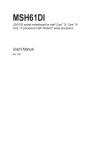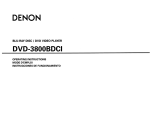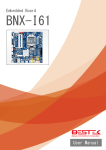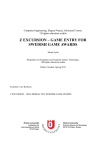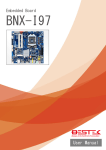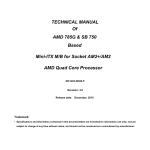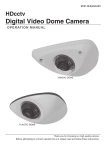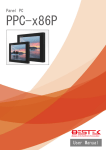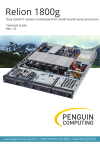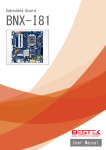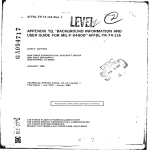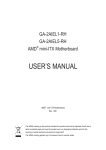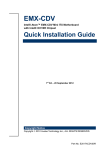Download MSH61PI - Index of
Transcript
MSH61PI LGA1155 socket motherboard for Intel® Core™ i3 / Core™ i5 Core™ i7 processors/ Intel® Pentium® series processors User's Manual Rev. 1001 Copyright © 2011 GIGA-BYTE TECHNOLOGY CO., LTD. All rights reserved. The trademarks mentioned in this manual are legally registered to their respective owners. Disclaimer Information in this manual is protected by copyright laws and is the property of GIGABYTE. Changes to the specifications and features in this manual may be made by GIGABYTE without prior notice. No part of this manual may be reproduced, copied, translated, transmitted, or published in any form or by any means without GIGABYTE's prior written permission. Documentation Classifications In order to assist in the use of this product, GIGABYTE provides the following types of documentations: For quick set-up of the product, read the Quick Installation Guide included with the product. For detailed product information, carefully read the User's Manual. For product-related information, check on our website at: http://www.gigabyte.com Table of Contents Box Contents....................................................................................................................4 MSH61PI Motherboard Layout.........................................................................................5 Chapter 1 Hardware Installation......................................................................................7 1-1 1-2 Installation Precautions..................................................................................... 7 Product Specifications....................................................................................... 8 1-3-2 1-4 Installing the Memory...................................................................................... 12 1-4-1 1-4-2 1-5 1-6 Installing the CPU Cooler........................................................................................11 Dual Channel Memory Configuration......................................................................12 Installing a Memory ................................................................................................13 Back Panel Connectors................................................................................... 14 Internal Connectors......................................................................................... 16 Chapter 2 BIOS Setup...................................................................................................25 2-1 2-2 The Main Menu............................................................................................... 27 Advanced Menu.............................................................................................. 29 2-2-1 2-2-2 2-2-2-1 2-2-3 2-2-4 2-2-5 2-2-6 2-2-7 2-2-8 2-2-9 2-2-10 2-3 Chipset Menu.................................................................................................. 45 2-3-1 2-3-2 2-3-3 2-4 2-5 2-6 ACPI Settings..........................................................................................................30 CPU Configuration...................................................................................................31 Socket 0 CPU Information.......................................................................................34 SATA Configuration.................................................................................................35 Acoustic Management Configuration.......................................................................37 Intel IGD SWSCI OpRegion ...................................................................................38 Intel TXT(LT) Configuration.....................................................................................40 USB Configuration...................................................................................................41 Super IO Configuration............................................................................................42 H/W Monitor.............................................................................................................43 AMT Configuration...................................................................................................44 North Bridge............................................................................................................46 South Bridge............................................................................................................48 ME Subsystem........................................................................................................51 Boot Menu....................................................................................................... 53 Security Menu................................................................................................. 55 Exit Menu........................................................................................................ 56 -3- Box Contents MSH61PI motherboard Driver CD Two SATA cables I/O Shield • The box contents above are for reference only and the actual items shall depend on the product package you obtain. The box contents are subject to change without notice. • The motherboard image is for reference only. -4- MSH61PI Motherboard Layout -5- Item 1 2 3 4 5 6 7 8 9 10 11 12 13 14 15 16 17 18 19 20 21 22 23 24 Code SPEK LINE_IN SPDIF R_USB2 R_USB1 HDMI LAN1 DC_IN MIN_PCIE1 BAT1 CLR_CMOSHW F_PANEL SATA1/SATA2 HDD_PWR F_USB1 F_AUDIO1 CPU1 CPU_FAN FPD LVDS DMIC_CON WEB_CON SODIMMB1 SODIMMA1 Description Speaker cable connector Audio Line In port Optical S/PDIF Out connector USB 3.0 ports USB 2.0 ports HDMI port RJ45 LAN port DC In power connector Mini PCi Express connector Battery socket Clear CMOS jumper Front panel cable connector SATA cable connectors Hard disk power connector USB connector Audio cable connector Intel LGA1155 socket CPU fan cable connector Flat Panel Display connector LVDS connector Digital Mic connector WEBCAM connector DDR3 SO-DIMM slot (channel B-1 ) DDR3 SO-DIMM slot (channel A-1 ) -6- MSH61PI LGA1155 socket motherboard for Intel® Core™ i3 / Core™ i5 Core™ i7 processors/ Intel® Pentium® series processors User's Manual Rev. 1001 Copyright © 2011 GIGA-BYTE TECHNOLOGY CO., LTD. All rights reserved. The trademarks mentioned in this manual are legally registered to their respective owners. Disclaimer Information in this manual is protected by copyright laws and is the property of GIGABYTE. Changes to the specifications and features in this manual may be made by GIGABYTE without prior notice. No part of this manual may be reproduced, copied, translated, transmitted, or published in any form or by any means without GIGABYTE's prior written permission. Documentation Classifications In order to assist in the use of this product, GIGABYTE provides the following types of documentations: For quick set-up of the product, read the Quick Installation Guide included with the product. For detailed product information, carefully read the User's Manual. For product-related information, check on our website at: http://www.gigabyte.com Table of Contents Box Contents....................................................................................................................4 MSH61PI Motherboard Layout.........................................................................................5 Chapter 1 Hardware Installation......................................................................................7 1-1 1-2 Installation Precautions..................................................................................... 7 Product Specifications....................................................................................... 8 1-3-2 1-4 Installing the Memory...................................................................................... 12 1-4-1 1-4-2 1-5 1-6 Installing the CPU Cooler........................................................................................11 Dual Channel Memory Configuration......................................................................12 Installing a Memory ................................................................................................13 Back Panel Connectors................................................................................... 14 Internal Connectors......................................................................................... 16 -3- Box Contents MSH61PI motherboard Driver CD Two SATA cables I/O Shield • The box contents above are for reference only and the actual items shall depend on the product package you obtain. The box contents are subject to change without notice. • The motherboard image is for reference only. -4- MSH61PI Motherboard Layout -5- Item 1 2 3 4 5 6 7 8 9 10 11 12 13 14 15 16 17 18 19 20 21 22 23 24 Code SPEK LINE_IN SPDIF R_USB2 R_USB1 HDMI LAN1 DC_IN MIN_PCIE1 BAT1 CLR_CMOSHW F_PANEL SATA1/SATA2 HDD_PWR F_USB1 F_AUDIO1 CPU1 CPU_FAN FPD LVDS DMIC_CON WEB_CON SODIMMB1 SODIMMA1 Description Speaker cable connector Audio Line In port Optical S/PDIF Out connector USB 3.0 ports USB 2.0 ports HDMI port RJ45 LAN port DC In power connector Mini PCi Express connector Battery socket Clear CMOS jumper Front panel cable connector SATA cable connectors Hard disk power connector USB connector Audio cable connector Intel LGA1155 socket CPU fan cable connector Flat Panel Display connector LVDS connector Digital Mic connector WEBCAM connector DDR3 SO-DIMM slot (channel B-1 ) DDR3 SO-DIMM slot (channel A-1 ) -6- Chapter 1 Hardware Installation 1-1 Installation Precautions The motherboard contains numerous delicate electronic circuits and components which can become damaged as a result of electrostatic discharge (ESD). Prior to installation, carefully read the user's manual and follow these procedures: • Prior to installation, do not remove or break motherboard S/N (Serial Number) sticker or warranty sticker provided by your dealer. These stickers are required for warranty validation. • Always remove the AC power by unplugging the power cord from the power outlet before installing or removing the motherboard or other hardware components. • When connecting hardware components to the internal connectors on the motherboard, make sure they are connected tightly and securely. • When handling the motherboard, avoid touching any metal leads or connectors. • It is best to wear an electrostatic discharge (ESD) wrist strap when handling electronic components such as a motherboard, CPU or memory. If you do not have an ESD wrist strap, keep your hands dry and first touch a metal object to eliminate static electricity. • Prior to installing the motherboard, please have it on top of an antistatic pad or within an electrostatic shielding container. • Before unplugging the power supply cable from the motherboard, make sure the power supply has been turned off. • Before turning on the power, make sure the power supply voltage has been set according to the local voltage standard. • Before using the product, please verify that all cables and power connectors of your hardware components are connected. • To prevent damage to the motherboard, do not allow screws to come in contact with the motherboard circuit or its components. • Make sure there are no leftover screws or metal components placed on the motherboard or within the computer casing. • Do not place the computer system on an uneven surface. • Do not place the computer system in a high-temperature environment. • Turning on the computer power during the installation process can lead to damage to system components as well as physical harm to the user. • If you are uncertain about any installation steps or have a problem related to the use of the product, please consult a certified computer technician. -7- Hardware Installation 1-2 Product Specifications CPU Support for Intel® Core™ i7, Core™i5, Core™i3 processors/Intel® Pentium ® processors in the LGA1155 package Support Up to 65W L3 cache varies with CPU Chipset Intel® H61 Express chipset Memory Audio LAN Dual channel SODIMM DDR3 Support for DDR3 1333/1066 MHz memory modules Support Up to 4GB Realtek ALC887 codec High Definition Audio 2/4/5.1-channel 1 x Realtek RTL8111E-VL-CG supports 10/100/1000 Mbps Expansion Slots 1 x Mini PCI Express slot Onboard Build in Intel® processor Graphics Storage Interface 2 x SATA 3Gb/s connectors USB Internal Connectors Back Panel Connectors Hardware Installation 2 x USB 3.0 ports (back panel) 2 x USB 2.0 ports (back panel) 1 x USB 2.0 connector (2 via the USB brackets connected to the internal USB headers) 2 x SATA 3Gb/s connectors 1 x HDD power connector 1 x CPU fan header 1 x front panel header 1 x audio header 2 x USB 2.0 headers 1 x Speaker header 1 x LVDS connector 1 x FPD connector 1 x Web CAM connector 1 x DC-IN 1 x RJ-45 port 1 x HDMI port 2 x USB 3.0 ports 2 x USB 2.0 ports 1 x SPDIF port 1 x Audio Line In -8- Hardware Monitor BIOS CPU/System temperature detection CPU fan speed detection 1 x 64 Mbit flash AMI BIOS Form Factor Mini ITX Form Factor; 170cm x 170cm * GIGABYTE reserves the right to make any changes to the product specifications and product-related information without prior notice. -9- Hardware Installation B. Follow the steps below to correctly install the CPU into the motherboard CPU socket. Before installing the CPU, make sure to turn off the computer and unplug the power cord from the power outlet power plug to prevent any damage to prevent damage to the CPU. Step 1: Gently press the CPU socket lever handle down and away from the socket with your finger. Then completely lift the CPU socket lever and the metal load plate will be lifted as well. Step 2: Remove the CPU socket cover as shown. Hold your index finger down on the rear grip of the socket cover and use your thumb to lift up the front edge (next to the "REMOVE" mark) and then remove the cover. (DO NOT touch socket contacts. To protect the CPU socket, always replace the protective socket cover when the CPU is not installed.) Step 3: Hold the CPU with your thumb and index fingers. Align the CPU pin one marking (triangle) with the pin one corner of the CPU socket (or you may align the CPU notches with the socket alignment keys) and gently insert the CPU into position. Step 4: Once the CPU is properly inserted, use one hand to hold the socket lever and use the other to lightly replace the load plate. When replacing the load plate, make sure the front end of the load plate is under the shoulder screw. Step 5: Push the CPU socket lever back into its locked position. NOTE: Hold the CPU socket lever by the handle, not the lever base portion. Hardware Installation - 10 - 1-3-2 Installing the CPU Cooler Follow the steps below to correctly install the CPU cooler on the motherboard. (The following procedure uses Intel® boxed cooler as the example cooler.) Male Push Pin Direction of the Arrow Sign on the Male Push Pin The Top of Female Push Pin Female Push Pin Step 1: Apply an even and thin layer of thermal paste on the surface of the installed CPU. Step 3: Place the cooler atop the CPU, aligning the four push pins through the pin holes on the motherboard. Push down on the push pins diagonally. Step 5: After the installation, check the back of the motherboard. If the push pin is inserted as the picture above shows, the installation is complete. Step 2: Before installing the cooler, note the direction of the arrow sign on the male push pin. (Turning the push pin along the direction of the arrow is for removing the cooler, and the opposite direction is for installing it..) Step 4: You should hear a "click" when pushing down each push pin. Check that the Male and Female push pins are joined closely. (Refer to your CPU cooler installation manual for instructions on installing the cooler.) Step 6: Finally, attach the power connector of the CPU cooler to the CPU fan header (CPU_FAN) on the motherboard. Use extreme care when removing the CPU cooler because the thermal grease/tape between the CPU cooler and CPU may adhere to the CPU. Inadequately removing the CPU cooler may damage the CPU. - 11 Hardware Installation 1-4 Installing the Memory Read the following guidelines before you begin to install the memory: • Make sure that the motherboard supports the memory. It is recommended that memory of the same capacity, brand, speed, and chips be used. (Go to GIGABYTE's website for the latest supported memory speeds and memory modules.) • Always turn off the computer and unplug the power cord from the power outlet before installing the memory to prevent hardware damage. • Memory modules have a foolproof design. A memory module can be installed in only one direction. If you are unable to insert the memory, switch the direction. 1-4-1 Dual Channel Memory Configuration This motherboard provides two DDR3 memory sockets and supports Dual Channel Technology. After the memory is installed, the BIOS will automatically detect the specifications and capacity of the memory. Enabling Dual Channel memory mode will double the original memory bandwidth. The two DDR3 memory sockets are divided into two channels and each channel has two memory sockets as following: SODIMMB1 SODIMMA1 Due to CPU limitations, read the following guidelines before installing the memory in Dual Channel mode. 1. Dual Channel mode cannot be enabled if only one DDR3 memory module is installed. 2. When enabling Dual Channel mode with two memory modules, it is recommended that memory of the same capacity, brand, speed, and chips be used for optimum performance. Hardware Installation - 12 - 1-4-2 Installing a Memory Before installing a memory module, make sure to turn off the computer and unplug the power cord from the power outlet to prevent damage to the memory module. Be sure to install DDR3 DIMMs on this motherboard. Installation Step: Installation Step: Step 1. Align the memory with the DIMM module and insert the DIMM memory module into the DIM slot. Please note that memory module has a foolproof insertion design. A memory module can be installed In only one direction. Step 2. Push down the memory and seat it firmly. 1 2 - 13 - Hardware Installation 1-5 Back Panel Connectors DC Power Jack Connect the DC power to this port. RJ-45 LAN Port The Gigabit Ethernet LAN port provides Internet connection at up to 1 Gbps data rate. The following describes the states of the LAN port LEDs. HDMI Port The HDMI (High-Definition Multimedia Interface) provides an all-digital audio/video interface to transmit the uncompressed audio/video signals and is HDCP compliant. Connect the HDMI audio/video device to this port. The HDMI Technology can support a maximum resolution of 1920x1080p but the actual resolutions supported depend on the monitor being used. • • When After installing the HDMI device, make sure the default device for sound playback is the HDMI device. (The item name may differ by operating system. Refer the figures below for details.), and enter BIOS Setup, then set Onboard VGA output connect to D-SUB/ HDMI under Advanced BIOS Features.. Please note the HDMI audio output only supports AC3, DTS and 2-channel-LPCM formats. (AC3 and DTS require the use of an external decoder for decoding.) USB 2.0 Port The USB port supports the USB 2.0 specification. Use this port for USB devices such as a USB keyboard/mouse, USB printer, USB flash drive and etc. USB 3.0 Port The USB port supports the USB 3.0 specification. Use this port for USB devices such as a USB keyboard/mouse, USB printer, USB flash drive and etc. Optical S/PDIF Out Connector This connector provides digital audio out to an external audio system that supports digital optical audio. Before using this feature, ensure that your audio system provides an optical digital audio in connector. Line In Jack (Blue) The default line in jack. Use this audio jack for line in devices such as an optical drive, walkman, etc. - 14 - Hardware Installation Connection/ Speed LED Activity LED LAN Port Connection/Speed LED: State Orange Green Off Activity LED: Description 1 Gbps data rate 100 Mbps data rate 10 Mbps data rate State Description Blinking Data transmission or receiving is occurring Off No data transmission or receiving is occurring • When removing the cable connected to a back panel connector, first remove the cable from your device and then remove it from the motherboard. • When removing the cable, pull it straight out from the connector. Do not rock it side to side to prevent an electrical short inside the cable connector. Hardware Installation - 15 - 1-6 Internal Connectors 1) 2) 3) 4) 5) 6) 7) F_PANEL SATA1/2 HDD_PWR F_USB1 F_AUDIO CPU_FAN FPD 8) 9) 10) 11) 12) 13) LVDS DMIC_CON WEB_CON SPEK BAT CLR_CMOSHW Read the following guidelines before connecting external devices: • First make sure your devices are compliant with the connectors you wish to connect. • Before installing the devices, be sure to turn off the devices and your computer. Unplug the power cord from the power outlet to prevent damage to the devices. • After installing the device and before turning on the computer, make sure the device cable has been securely attached to the connector on the motherboard. - 16 - Hardware Installation 1) F_PANEL (Front Panel Header) Connect the power switch, reset switch, speaker, chassis intrusion switch/sensor and system status indicator on the chassis to this header according to the pin assignments below. Note the positive and negative pins before connecting the cables. 12 11 2 1 Pin No. 1 2 3 4 5 6 7 8 9 10 11 12 Signal Name HDD LED + Power LED+ HDD LED - Power LED- GND Power Switch+ RST GND LED_WLAN NA PCH_GPIO1 PCH_GPIO6 Definition Hard Disk LED Signal anode (+) Power LED Signal anode (+) Hard Disk LED Signal cathode(-) Power LED Signal cathode(-) Ground Power Button anode (+) Reset Button Ground Wireless LAN active LED Signal anode (+) No Connect Brigtness up Button Signal Brigtness down Button Signal The front panel design may differ by chassis. A front panel module mainly consists of power switch, reset switch, power LED, hard drive activity LED, speaker and etc. When connecting your chassis front panel module to this header, make sure the wire assignments and the pin assignments are matched correctly. - 17 - Hardware Installation 2) SATA1/2 (SATA 3Gb/s Connectors) The SATA connectors conform to SATA 3Gb/s standard and are compatible with SATA 1.5Gb/s standard. Each SATA connector supports a single SATA device. SATA1 SATA2 7 1 Pin No. 1 2 3 4 5 6 7 Definition GND TXP TXN GND RXN RXP GND 3) HDD_PWR (HDD Power Connector) 5 Hardware Installation - 18 - 1 Pin No. 1 2 3 4 5 Definition +12V GND VCC VCC GND F_PANEL 4) F_USB1 (USB Headers) PWR_LED IR The headers conform to USB 2.0/1.1 specification. Each USB header can provide two USB ports COMB via an optional USB bracket. For purchasing the optional USB bracket, please contact the local dealer. 2 10 1 9 F_USB CLR_CMOS BIOS_WP CLR_CMOS BIOS_WP Pin No. 1 2 3 4 5 6 7 8 9 10 Definition USB Power 5V USB Power 5V USB DUSB DUSB D+ USB D+ GND GND No Pin GND COMB SUR_CEN CI Power CLR_PWD F_PANEL DPVRM 5) F_AUDIO (Front Panel Audio Header) The front panel audio header supports Intel High Definition audio (HD) and AC'97 audio. You may connect your chassis front panel audio module to MODEM this header. Make sure the wire assignments of the module connector match the pin assignments of theF_AUDIO motherboard header. Incorrect connection between the module Smart Card Reader connector and the motherboard header will make the device unable to work or even damage it. F_PANEL F1_1394 F_AUDIO SPDIF_IO 2 10 1 9 F_PANEL GAME For AC'97 Front Panel Audio: Pin No. Definition 1 MIC in L 2 GND 3 MIC in R 4 PCH_GPIO68 F2_1394 5 Line out R 6 MIC Jack detect 7 GND 8 No Pin F_USB 9 Line out L F_1394 10 Line out jack detect • The front panel audio header supports HD audio by default. • Audio signals will be present on both of the front and back panel audio connections simultaneIR/CIR ously. • Some chassis provide a front panel audio module thatSMB_CONN has separated connectors on each wire instead of a single plug. For information about connecting the front panel audio module that has different wire assignments, please contact the chassis manufacturer. F_AUDIO (NEW) F_PANEL IR - 19 - Hardware Installation COMB 6) CPU_FAN (CPU Fan Headers) The motherboard has a 4-pin CPU fan header (CPU_FAN) headers. Most fan headers possess a foolproof insertion design. When connecting a fan cable, be sure to connect it in the correct orientation (the black connector wire is the ground wire). The motherboard supports CPU fan speed control, which requires the use of a CPU fan with fan speed control design. For optimum heat dissipation, it is recommended that a system fan be installed inside the chassis. 1 Pin No. 1 2 3 4 Definition GND +12V Sense Speed Control • Be sure to connect fan cables to the fan headers to prevent your CPU and system from overheating. Overheating may result in damage to the CPU or the system may hang. • These fan headers are not configuration jumper blocks. Do not place a jumper cap on the headers. 7) FPD (Flat Panel Display Headers) Flat Panel Display (FPD)is a high-speed interface connecting the output of a video controller in a laptop computer, computer monitor or LCD television set to the display panel. Most laptops, LCD computer monitors and LCD TVs use this interface internally. The headers conform to FPD specification. 1 8 Hardware Installation - 20 - Pin No. 1 2 3 4 5 6 7 8 Definition Backlight Enable Backlight control FPD_19V FPD_19V GND GND Brighrness Up Brighrness Down 8) LVDS (LVDS Headers) LVDS stands for Low-voltage differential signaling, which uses high-speed analog circuit techniques to provide multigigabit data transfers on copper interconnects and is a generic interface standard for high-speed data transmission. Pin No. 1 2 3 4 5 6 7 8 9 10 11 12 13 14 15 16 17 18 19 20 Definition +RXO3 -RXO3 +RXO2 -RXO2 +RXO1 -RXO1 +RXO0 -RXO0 +RXE3 -RXE3 +RXE2 -RXE2 +RXE1 -RXE1 +RXE0 -RXE0 GND LCDVCC LCDVCC LCDVCC Pin No. 21 22 23 24 25 26 27 28 29 30 31 32 33 34 35 36 37 38 39 40 - 21 - Definition NC VCC3 GND GND GND +RXECLKO -RXECLKO GND GND GND SCL BKLTEN BKLTCTL +RXECLKE -RXECLKE FPD_19V FPD_19V FPD_19V NC SDA Hardware Installation 9) DMIC_CON (DMIC Headers) 1 4 Pin No. 1 2 3 4 Definition Power DMICDATA GND DMICCLK Pin No. 1 2 3 4 Definition Power USB DUSB D+ GND 10) WEB_CON (WebCAM Headers) 1 4 Hardware Installation - 22 - 11) SPEK (Speaker Headers) 4 1 Pin No. 1 2 3 4 Definition Speaker OUT LSpeaker OUT L+ Speaker OUT R+ Speaker OUT R- 12) BAT (Battery) The battery provides power to keep the values (such as BIOS configurations, date, and time information) in the CMOS when the computer is turned off. Replace the battery when the battery voltage drops to a low level, or the CMOS values may not be accurate or may be lost. You may clear the CMOS values by removing the battery: 1. Turn off your computer and unplug the power cord. 2. Gently remove the battery from the battery holder and wait for one minute. (Or use a metal object like a screwdriver to touch the positive and negative terminals of the battery holder, making them short for 5 seconds.) 3. Replace the battery. 4. Plug in the power cord and restart your computer. • Always turn off your computer and unplug the power cord before replacing the battery. • Replace the battery with an equivalent one. Danger of explosion if the battery is replaced with an incorrect model. • Contact the place of purchase or local dealer if you are not able to replace the battery by yourself or uncertain about the battery model. • When installing the battery, note the orientation of the positive side (+) and the negative side (-) of the battery (the positive side should face up). • Used batteries must be handled in accordance with local environmental regulations. - 23 - Hardware Installation 13) CLR_CMOSHW (Clearing CMOS Jumper) Use this jumper to clear the CMOS values (e.g. date information and BIOS configurations) and reset the CMOS values to factory defaults. To clear the CMOS values, place a jumper cap on the two pins to temporarily short the two pins or use a metal object like a screwdriver to touch the two pins for a few seconds. Open: Normal operation (Default setting) Close: Clear CMOS data • Always turn off your computer and unplug the power cord from the power outlet before clearing the CMOS values. • After clearing the CMOS values and before turning on your computer, be sure to remove the jumper cap from the jumper. Failure to do so may cause damage to the motherboard. • After system restart, go to BIOS Setup to load factory defaults (select Load Optimized Defaults) or manually configure the BIOS settings (refer to Chapter 2, "BIOS Setup," for BIOS configurations). Hardware Installation - 24 - Chapter 2 BIOS Setup BIOS (Basic Input and Output System) records hardware parameters of the system in the CMOS on the motherboard. Its major functions include conducting the Power-On Self-Test (POST) during system startup, saving system parameters and loading operating system, etc. BIOS includes a BIOS Setup program that allows the user to modify basic system configuration settings or to activate certain system features. When the power is turned off, the battery on the motherboard supplies the necessary power to the CMOS to keep the configuration values in the CMOS. To access the BIOS Setup program, press the <DEL> key during the POST when the power is turned on. To see more advanced BIOS Setup menu options, you can press <Ctrl> + <F1> in the main menu of the BIOS Setup program. • BIOS flashing is potentially risky, if you do not encounter problems of using the current BIOS version, it is recommended that you don't flash the BIOS. To flash the BIOS, do it with caution. Inadequate BIOS flashing may result in system malfunction. • It is recommended that you not alter the default settings (unless you need to) to prevent system instability or other unexpected results. Inadequately altering the settings may result in system's failure to boot. If this occurs, try to clear the CMOS values and reset the board to default values. (Refer to the "Load Optimized Defaults" section in this chapter or introductions of the battery/ clearing CMOS jumper in Chapter 1 for how to clear the CMOS values.) BIOS Setup Program Function Keys <h><i><f><g>Move the selection bar to select an item <Enter> Execute command or enter the submenu <Esc> Main Menu: Exit the BIOS Setup program Submenus: Exit current submenu <Page Up> Increase the numeric value or make changes <Page Down> Decrease the numeric value or make changes <F1> Show descriptions of the function keys <F2> Move cursor to the Item Help block on the right (submenus only) <F5> Restore the previous BIOS settings for the current submenus <F6> Load the Fail-Safe BIOS default settings for the current submenus <F7> Load the Optimized BIOS default settings for the current submenus <F8> Access the Q-Flash utility <F9>Display system information <F10> Save all the changes and exit the BIOS Setup program <F11> Save CMOS to BIOS <F12> Load CMOS from BIOS - 25 - BIOS Setup The Functions of the <F11> and <F12> keys (For the Main Menu Only) F11: Save CMOS to BIOS This function allows you to save the current BIOS settings to a profile. You can create up to 8 profiles (Profile 1-8) and name each profile. First enter the profile name (to erase the default profile name, use the SPACE key) and then press <Enter> to complete. F12: Load CMOS from BIOS If your system becomes unstable and you have loaded the BIOS default settings, you can use this function to load the BIOS settings from a profile created before, without the hassles of reconfiguring the BIOS settings. First select the profile you wish to load, then press <Enter> to complete. Advanced This setup page includes all the items of AMI BIOS special enhanced features. (ex: Auto detect fan and temperature status, automatically configure hard disk parameters.) Chipset Northbridge and Southbridge additional features configuration. Boot This setup page provides items for configuration of boot sequence. Security Change, set, or disable supervisor and user password. Configuration supervisor password allows you to restrict access to the system and BIOS Setup. A supervisor password allows you to make changes in BIOS Setup. A user password only allows you to view the BIOS settings but not to make changes. Save & Exit Save all the changes made in the BIOS Setup program to the CMOS and exit BIOS Setup. (Pressing <F10> can also carry out this task.) Abandon all changes and the previous settings remain in effect. Pressing <Y> to the confirmation message will exit BIOS Setup. (Pressing <Esc> can also carry out this task.) - 26 - BIOS Setup 2-1 The Main Menu Once you enter the BIOS Setup program, the Main Menu (as shown below) appears on the screen. Use arrow keys to move among the items and press <Enter> to accept or enter other sub-menu. Main Menu Help The on-screen description of a highlighted setup option is displayed on the bottom line of the Main Menu. Submenu Help While in a submenu, press <F1> to display a help screen (General Help) of function keys available for the menu. Press <Esc> to exit the help screen. Help for each item is in the Item Help block on the right side of the submenu. • If you do not find the settings you want in the Main Menu or a submenu, press <Ctrl>+<F1> to access more advanced options. • When the system is not stable as usual, select the Restore Defaults item to set your system to its defaults. • The BIOS Setup menus described in this chapter are for reference only and may differ by BIOS version. - 27 - BIOS Setup BIOS Version Display version number of the BIOS setup utility. BIOS Vendor Display BIOS vendor information. Core Version Display version of the processor. Compliency Display compliency information. Project Version Display version number of the project. BIOS Build Date and Time Displays the date and time when the BIOS setup utility was created. MAC Address Displays the MAC address information. Total Memory Determines how much total memory is present during the POST. System Language Select the system default language. System Date Set the date following the weekday-month-day- year format. System Time Set the system time following the hour-minute- second format. Access Level Display current access level information. BIOS Setup - 28 - 2-2 Advanced Menu The Advanced menu display submenu options for configuring the function of various hardware components. Select a submenu item, then press Enter to access the related submenu screen. Launch PXE OPROM Enable/Disable Boot Option for PXE device with option ROM. Options available: Enabled/Disabled. Default setting is Disabled. Launch Storage OPROM Enable/Disable Boot Option for Legacy Mass Storage device with option ROM. Options available: Enabled/Disabled. Default setting is Enabled. - 29 - BIOS Setup 2-2-1 ACPI Settings Enable ACPI Auto Configuration Enable/Disable BIOS ACPI Auto Configuration. Options available: Enabled/Disabled. Default setting is Disabled. Enable Hibernation Enable/Disable system ability to hibernate (OS/S4 Sleep State). Options available: Enabled/Disabled. Default setting is Enabled. ACPI Sleep State Select the highest ACPI sleep state the system will enter, when the suspend button is pressed. Suspend Disabled/S1 (CPU Stop Clock)/S3 (Suspend to RAM). Default setting is S3 (Suspend to RAM). Lock Legacy Resources Enable/Disable Lock Legacy Resources. Options available: Enabled/Disabled. Default setting is Disabled. - 30 - BIOS Setup 2-2-2 CPU Configuration BIOS Setup - 31 - CPU Information This category includes all the information of CPU Speed and supported 64-Bit information. Hyper Threading The Intel Hyper Threading Technology allows a single processor to execute two or more separate threads concurrently. When hyper-threading is enabled, multi-threaded software applications can execute their threads, thereby improving performance. Options available: Enabled/Disabled. Default setting is Enabled. Active Processor Cores (Note) Allows you to determine whether to enable all CPU cores. Options available: All/1/2/3. Default setting is All. Limit CPUID Maximum Allows you to determine whether to enable CLimit CPUID Maximum function Options available: Enabled/Disabled. Default setting is Disabled. Execute Disable Bit When this item enabled, the processor prevents the execution of code in data-only memory pages. This provides some protection against buffer overflow attacks. Options available: Enabled/Disabled. Default setting is Enabled. Hardware Prefetcher Select whether to enable the speculative prefetch unit of the processor. Options available: Enabled/Disabled. Default setting is Enabled. Adjacent Cache Line Prefetch When enabled, cache lines are fetched in pairs. When disabled, only the required cache line is fetched. Options available: Enabled/Disabled. Default setting is Enabled. Intel Virtualization Technology Select whether to enable the Intel Virtualization Technology function. VT allows a single platform to run multiple operating systems in independent partitions. Options available: Enabled/Disabled. Default setting is Disabled. Power Technology Determine the CPU power saving type. Options available:Disabled/Custom/Energy Efficient. Default setting is Custom. EIST (Enhanced Intel SpeedStep Technology) Conventional Intel SpeedStep Technology switches both voltage and frequency in tandem between high and low levels in response to processor load. Options available: Enabled/Disabled. Default setting is Enabled. Turbo Mode When this feature is enabled, the processor can dynamically overclock one or two of its four processing cores to improve performance with applications that are not multi-threaded or optimized for quad-core processors. Options available: Enabled/Disabled. Default setting is Enabled. P-State Coordination In HW_ALL mode, the processor hardware is responsible for coordinating the P-state among logical processors dependencies. The OS is responsible for keeping the P-state request up to date on all logical processors. In SW_ALL mode, the OS Power Manager is responsible for coordinating the P-state among logical BIOS Setup - 32 - processors with dependencies and must initiate the transition on all of those Logical Processors. In SW_ANY mode, the OS Power Manager is responsible for coordinating the P-state among logical processors with dependencies and may initiate the transition on any of those Logical Processors. Options available: HW_ALL/SW_ALL/SW_ANY. Default setting is HW_ALL. CPU C3/C6 Support (Note) Allows you to determine whether to let the CPU enter C3/C6 mode in system halt state. When enabled, the CPU core frequency and voltage will be reduced during system halt state to decrease power consumption. The C3/C6 state is a more enhanced power-saving state than C1. Auto lets the BIOS automatically configure this setting. Options available for CPU C3 Report: ACPI C2/ACPI C3/Disabled. Default setting is ACPI C2. Options available for CPU C6 Report: Enabled/Disabled. Default setting is Enabled. Package C State Limit Configure state for the C-State package limit. Options available: C0/C1/C6/C7/No Limit. Default setting is No Limit. Local x2APIC Enable/Disable Local x2APIC. Options available: Enabled/Disabled. Default setting is Disabled. Factory long duration power limit Display the information of Factory long duration power limit. Long duration power limit Press numeric keys to determine desire values. Factory long duration maintained Display the information of Factory long duration power limit. Long duration maintained Press numeric keys to determine desire values. Recommended short duration power limit Display the information of Recommended short duration power limit. Short duration power limit Press numeric keys to determine desire values. (Note) This item is present only if you install a CPU that supports this feature. For more information about Intel CPUs' unique features, please visit Intel's website. BIOS Setup - 33 - 2-2-2-1Socket 0 CPU Information Spcket 0 CPU Information: The Socket 0 CPU information submenu is a simple display page for the installed processor ID information. Items on this window are non-configurable. BIOS Setup - 34 - 2-2-3 SATA Configuration SATA Mode Select the on chip SATA type. IDE Mode: When set to IDE, the SATA controller disables its RAID and AHCI functions and runs in the IDE emulation mode. This is not allowed to access RAID setup utility. RAID Mode: When set to RAID, the SATA controllerenables both its RAID and AHCI functions. You will be allows access the RAID setup utility at boot time. ACHI Mode: When set to AHCI,the SATA controller enables its AHCI functionality. Then the RAID function is disabled and cannot be access the RAID setup utility at boot time. Options available: IDE/RAID/ACHI. Default setting is IDE Mode. Serial-ATA 0/1 Controllers Determine the on chip SATA controller 0/1 mode. Enhanced: SATA and PATA drives are auto-detected and placed inNative mode. Compatible: SATA and PATA drives are auto-detected and placed inLegacy mode. Default setting for Serial-ATA 0 controller is Compatible. Default setting for Serial-ATA 1 controller is Enhanced. SATA Port 0/1 The category identifies Serial ATA types of hard disk that are installed in the computer. System will automatically detect HDD type. Note that the specifications of your drive must match with the drive table. The hard disk will not work properly if you enter improper information for this category. Hard drive information should be labeled on the outside device casing. Enter the appropriate option based on this information. - 35 - BIOS Setup Type Auto: Set parameters automatically. (Default setting) CD-ROM: Use for ATAPI CD-ROM drives or double click [Auto] to set all HDD parameters automatically. ARMD: Use ARMD drive is installed here. LBA/Large Mode Configure the device type in the specific IDE channel support LBA Mode. Option available: Auto/Disabled. Default setting is Auto. Block (Multi-Sector Transfer) Configure the information of Multi-Sector Transfer Mode. Auto: The data transfer from and to the device occurs multiple sectors at a time if the device supports it. Disabled: The data transfer from and to the device occurs one sector at a time. Option available: Auto/Disabled. Default setting is Auto. PIO Mode This feature allows you to set the PIO (Programmed Input/Output) mode for the two IDE devices (Master and Slave drives) attached to that particular IDE channel. Option available: Auto/Disabled. Default setting is Auto. PIO Mode This feature allows you to set the PIO (Programmed Input/Output) mode for the two IDE devices (Master and Slave drives) attached to that particular IDE channel. Option available: Auto/Disabled. Default setting is Auto. DMA Mode Configure the DMA mode of the device in the specific IDE channel. Option available: Auto/Disabled. Default setting is Auto. S.M.A.R.T Mode This feature allows you to set the PIO (Programmed Input/Output) mode for the two IDE devices (Master and Slave drives) attached to that particular IDE channel. Option available: Auto/Disabled. Default setting is Auto. S.M.A.R.T Mode This option enables/disables support for the hard disk's S.M.A.R.T. capability. The S.M.A.R.T. (Self Monitoring Analysis And Reporting) technology is supported by all current hard disks and it allows the early prediction and warning of impending hard disk disasters. Option available: Auto/Disabled. Default setting is Auto. 32Bit Data Transfer Configure the 32Bit Data Transfer rate. Option available: Auto/Disabled. Default setting is Auto. BIOS Setup - 36 - 2-2-4 Acoustic Management Configuration Automatic Acoustic Management Enable/Disable Automatic Acoustic Management function. Option available: Enabled/Disabled. Default setting is Disabled. BIOS Setup - 37 - 2-2-5 Intel IGD SWSCI OpRegion DVMT Mode Select Confiigure the DVMT Mode. Options available: DVMT Mode/Fixed Mode. Default setting is DVMT Mode. DVMT/Fixed Memory Select DVMT Pre-Allocated (Fixed) Graphics Memory size used by the Internal graphicsdevice. Options available: 128MB/256MB/Maximum. Default setting is 256MB. IGD - Boot Type Select the Video Device that will be activated during POST. Options available: VBIOS Default/CRT/LFP/CRT+LFP/CRT+LFP - SDVO/EFP/EFP2/EFP3/CRT+EFP Default setting is VBIOS Default. LCD Panel Type Selecting by Internal Graphics Device by selecting appropriate setup item. Options available: 800x600 LVDS/1024x768 LVDS/1280x1024 LVDS/1400x1050 LVDS1/1400x1050 LVDS2/ 1600x1200 LVDS/ 1280x768 LVDS/ 1380x1050 LVDS/1920x1200 LVDS/1280x800 LVDS/1280x600 LVDS/ 2048x1536 LVDS Panel Scaling Options available: Auto/Force Scaling/Off. Backlight Control Support Options available: Both BLC & BIA Disabled/BLC Enabled. BIA Conttol Options available: VBIOS Default/Disabled/Level 1/Level 2/Level 3/Level 4/Level 5. - 38 - BIOS Setup Spread Spectrum Clock Enable/Disabled Spread Spectrum Clock. Options available: Enabled/Disabled. Deafult setting is Disabled. TV Standard elect the TV standard used by the Internal graphics device. Options available: VBIOS Default/NTSC-M/NTSC-J/NTSC-443/PAL-B/PAL-G/PAL-D/PAL-H/PAL-I/PAL-K/PAL-M/PAL-N/ PAL-Nc/SECAM-L/SECAM-B/SECAM-D/SECAM-G/SECAM-H/SECAM-K/1080i59/1080i60/ 33K 576i @50Hz/31K 576p @50Hz/ 1080i50/1080p50/720p59/720p60/480p60/480p59/480i60/480i59/1 080p60/1080p59/1080i60/1080i59 - 39 - BIOS Setup 2-2-6 Intel TXT(LT) Configuration Intel TXT(LT) Configuration The Intel Trusted Execution Technology (TXT) submenu is a display page for the Intel TXT information. Items on this window are non-configurable. - 40 - BIOS Setup 2-2-7 USB Configuration Detected USB Devices Displays the information of installed USB devices in the system. Legacy USB Support Enables or disables support for legacy USB devices. Options available: Auto/Enabled/Disabled. Default setting is Enabled. USB 3.0 Suupport When enabled, the USB 3.0 controller will function normally. Options available: Enabled/Disabled. Default setting is Enabled. XHCI Hand-off Enable/Disable XHCI Hand-off function. Options available: Enabled/Disabled. Default setting is Enabled. EHCI Hand-off Enable/Disable EHCI Hand-off function. Options available: Enabled/Disabled. Default setting is Enabled. USB transfer time-out Define USB transfer start unit command timeout. Options available: 10 sec/20sec/30sec/40sec. Device reset time-out Define USB device reset start unit command timeout. Options available: 10 sec/20sec/30sec/40sec. Device power-up delay Define USB device powering up start unit command timeout. When this item is set to Manual, you can press numeric keys to configure desired values. Options available: Auto/Manual. - 41 BIOS Setup 2-2-8 Super IO Configuration Super IO Configuration The Super IO Configuration submenu is a display page for the Super IO chipset information. Items on this window are non-configurable. - 42 - BIOS Setup 2-2-9 H/W Monitor Press Enter to view the Hardware Monitor screen which displays a real-time record of the CPU/system temperature, and fan speed, Items on this window are non-configurable. System Temperature/CPU Temperature Displays current CPU and System temperature. FAN1 Speed (RPM) Displays current CPU fan speed. - 43 - BIOS Setup 2-2-10 AMT Configuration Unconfigure AMT/ME Enables/DisableUnconfigure AMT/ME function. Options available: Auto/Enabled/Disabled. Default setting is Enabled. Watchdog Timer Enable/Disable Watchdog timer function. Options available: Enabled/Disabled. Default setting is Disabled. OS Watchdog Timer Press numeric key to adjust desire values. BIOS Watchdog Timer Press numeric key to adjust desire values. BIOS Setup - 44 - 2-3 Chipset Menu - 45 - BIOS Setup 2-3-1 North Bridge Total Memory Total size of system memory detected during POST. DIMM Group #1/2/ Status The size of memory installed on each of the DDR3 slots. Low MMIO Align Determone Low MMIO resources align at 64MB or 1024MB. Option available: 64MB/1024MB. Default setting is 1024MB. DMI Gen2 Options available: Enabled/Disabled. Default setting is Enabled. VT-d Enable/Disable Intel VD-d Technology function. Options available: Enabled/Disabled. Default setting is Disabled. Iniate Graphic Adapter Select which graphic controller to use as primary boot device. Options available: IGD/PEG/IGD. Default setting is PEG/IGD. IGD Memory Determone the IGD shared memory size. Options available: 32M/64M/96M/128M/160M/192M/224M/256M/288M/320M/352M/384M/416M/448M/ 480M/512M/Disabled. Render Standby Enable/Disable Render Standby by internal graphics device. Options available: Enabled/Disabled. Default setting is Enabled. - 46 - BIOS Setup IGD Multi-Monitor Enable/Disable IGD Multi-Monitor by internal graphics device. Options available: Enabled/Disabled. Default setting is Enabled. PCI Express Port Configure PCI Express Port. Options available: Auto/Enabled/Disabled. Default setting is Auto. PEG Force Gen1 Enable/Disable PEG Force Gen1. Options available: Enabled/Disabled. Default setting is Disabled. Detect Non-Compliance Device Enable/Disable Detect Non-Compliance Device. Options available: Enabled/Disabled. Default setting is Disabled. MRC Message Print Enable/Disable Print Message Initialize message. Options available: Enabled/Disabled. Default setting is Disabled. - 47 - BIOS Setup 2-3-2 South Bridge - 48 - BIOS Setup SMBus Controller Enable/Disable onboard SMBus controller. Options available: Enabled/Disabled. Default setting is Enabled. Restore AC Power Loss This option provides user to set the mode of operation if an AC / power loss occurs. Power On: System power state when AC cord is re-plugged. Power Off: Do not power on system when AC power is back. Last State: Set system to the last sate when AC power is removed. Options available: Power On/Power Off/Last State. Default setting is Power Off. SLP_S4 Assertion Stretch Enable Enable/Disable SLP_S4 Assertion Stretch. Options available: Enabled/Disabled. Default setting is Enabled. SLP_S4 Assertion Width Configure SLP_S4 Assertion Width. Options available: [1-2 Seconds]/[2-3 Seconds]/[3-4 Seconds]/[4-5 Seconds]. Default setting is [4-5 Seconds]. Deep Sx & Disable WOL from S5 Deep Sx configuration. If this item set to enabled, the WOL from S5 will be disabled. Note: Mobile platforms support Deep S4/S5 in DC only and Desktop platforms support Deep S4/S5 in AC only. Options available: Disabled/Enabled in S5/Enabled in S4 and S5. Default setting is Enabled in S4 and S5. - 49 - BIOS Setup Azalia HD Audio Enable/Dsiable onboard audio device. Options available: Enabled/Disabled. Default setting is Enabled. Azalia internal HDMI codec Enable/Dsiable onboard Azalia internal HDMI codec. Options available: Enabled/Disabled. Default setting is Enabled. HDMI codec Port B Enable/Dsiable onboard HDMI codec Port B. Options available: Enabled/Disabled. Default setting is Enabled. High Precision Event Timer Enable/Dsiable High Precision Event Timer. Options available: Enabled/Disabled. Default setting is Enabled. PCI Express Ports Configuration PCI Express Port Group #1/2/3/4/5/6/7/8 Configuration Enable/Dsiable specific PCI Express Port in the chipset. Options available: Auto/Enabled/Disabled. Default setting is Enabled. PCIe Sub Decode Enable/Dsiable PCIe Sub Decode. Options available: Enabled/Disabled. Default setting is Disabled. USB Configuration All USB Devices Enable/Dsiable all onboard USB devices. Options available: Enabled/Disabled. Default setting is Enabled. EHCI Controller 1 Enable/Dsiable onboard EHCI controller 1. Options available: Enabled/Disabled. Default setting is Enabled. EHCI Controller 2 Enable/Dsiable onboard EHCI controller 2. Options available: Enabled/Disabled. Default setting is Enabled. USB Port Group #0/1/2/3 Enable/Dsiable specific USB Port in the chipset. Options available: Enabled/Disabled. Default setting is Enabled. - 50 - BIOS Setup 2-3-3 ME Subsystem - 51 - BIOS Setup ME Version Display the ME version information. ME Subsystem Enable/Dsiable ME Subsystem function. Options available: Enabled/Disabled. Default setting is Enabled. ME Temporary Disable Enable/Dsiable ME Temporary Disable function. Options available: Enabled/Disabled. Default setting is Disabled. End of Post Message Enable/Dsiable End of Post Message function. Options available: Enabled/Disabled. Default setting is Enabled. Execute MEBx Enable/Dsiable Execute MEBx function. Options available: Enabled/Disabled. Default setting is Disabled. MEBx Mode Configure MEBx Mode. Options available: Normal/Hidden Ctrl + p/ Enter MEBx Setup. Default setting is Normal. Integrated Clock Chip Configuration ICC OverClocking Lib Version Display ICC OverClocking Lib Version information. Number of ICC Profiles Display the Number of ICC Profiles information. Current ICC Profile Index Display Current ICC Profile Index information. ICC Enabled Enable/Disable Integrated Clock Chip. Options available: Enabled/Disabled. Default setting is Disabled. - 52 - BIOS Setup 2-4 Boot Menu The Boot menu allows you to set the drive priority during system boot-up. BIOS setup will display an error message if the drive(s) specified is not bootable. Setup Prompt Timeout Define Setup Prompt start unit command timeout. Press numeric keys to adjust desired values. Bootup NumLock State Allows you to select power-on state for NumLock function. Options available: On/Off. Default setting is On. Quick Boot Allow BIOS to skip certain tests while booting. Options available: Enabled/Disabled. Default setting is Enabled. Fast Boot Enable/Disable boot with initialization of a minimal set of devices required to launchactive boot option. Options available: Enabled/Disabled. Default setting is Enabled. CSM16 Module Version Displays the CSM16 Module Version information. GateA20 Active Upon Request: GA20 can be disabled using BIOS services. Always: do not allow disabling GA20; this option is useful when any RT code is executed above 1MB. Options available: Upon Request/Always. Default setting is Upon Request. BIOS Setup - 53 - Option ROM Messages Set display mode for Option ROM. Options available: Force BIOS/Keep Current . Default setting is Force BIOS. Interrupt 19 Capture Enable/Disable Interrupt 19 Capture Options available: Enabled/Disabled. Default setting is Disabled. - 54 - BIOS Setup 2-5 Security Menu The Security menu allows you to safeguard and protect the system from unauthorized use by setting up access passwords. There are two types of passwords that you can set: • Adminstrator Password Entering this password will allow the user to access and change all settings in the Setup Utility. • User Password Entering this password will restrict a user’s access to the Setup menus. To enable or disable this field, a Administrator Password must first be set. A user can only access and modify the System Time, System Date, and Set User Password fields. AdministratorPassword Press Enter to configure the Administrator password. User Password Press Enter to configure the user password. - 55 - BIOS Setup 2-6 Exit Menu The Exit menu displays the various options to quit from the BIOS setup. Highlight any of the exit options then press Enter. Save Changes and Exit Saves changes made and close the BIOS setup and exit system setup. Options available: Yes/No. Discard Changes and Exit Discards changes made and close the BIOS setup and exit system setup . Options available: Yes/No. Save Changes and Reset Active this option to reset system after saving the changes. Options available: Yes/No. Discard Changes and Reset Active this option to reset system after without saving any changes. Options available: Yes/No. Save Changes Active this option to save all the changes. Discard Changes Discards changes made and close the BIOS setup. Save as User Default Press <Enter> on this item and then press the <Y> key to load user default settings. Options available: Yes/No. Restore as User Defaults Press <Enter> on this item and then press the <Y> key to restore user default settings. BIOS Setup - 56 - Options available: Yes/No. Restore as User Defaults Press <Enter> on this item and then press the <Y> key to restore user default settings. Options available: Yes/No. Launch EFI Shell from filesystem device Press <Enter> on this item to Launch EFI Shell from filesystem device. BIOS Setup - 57 -































































